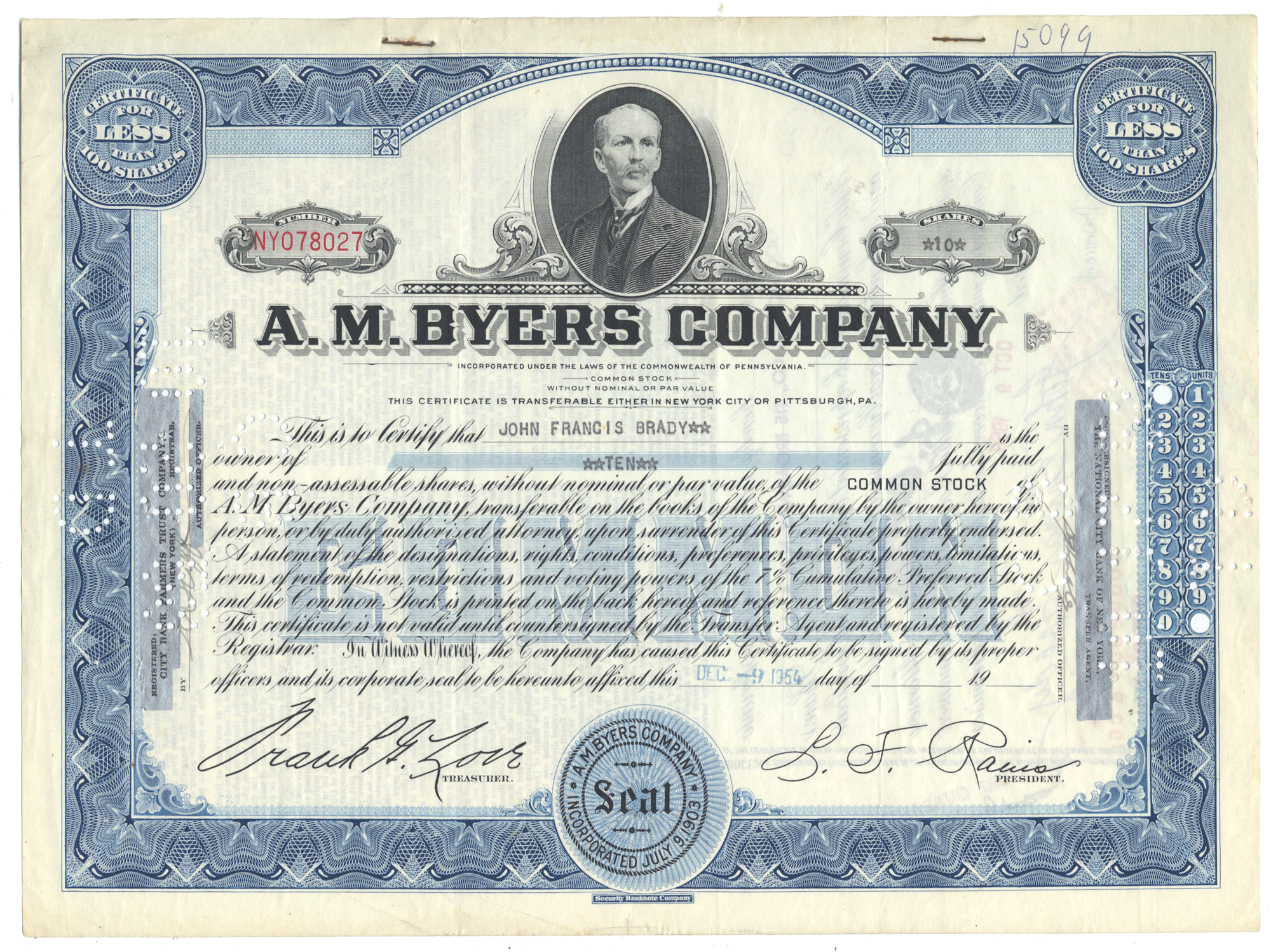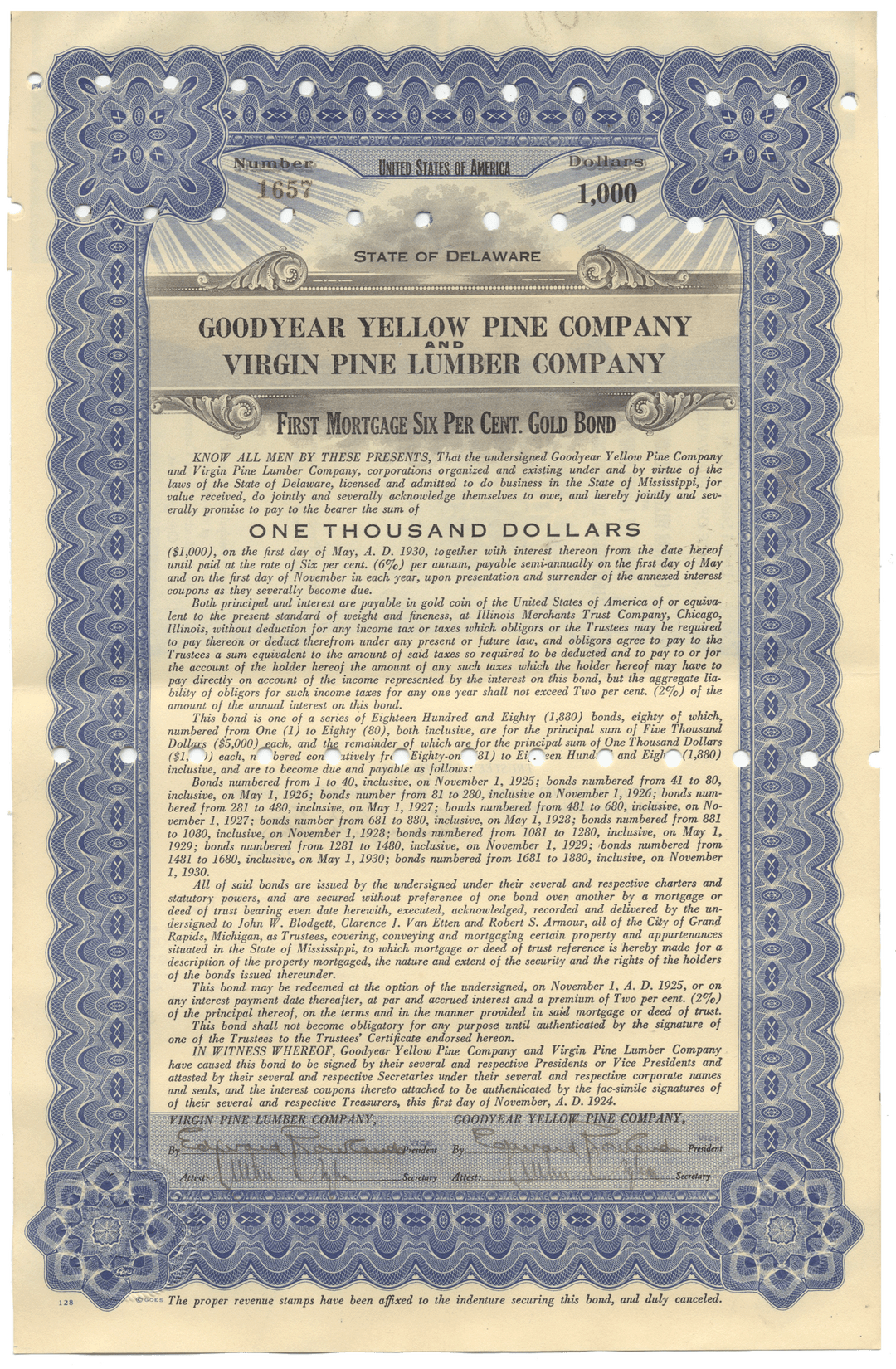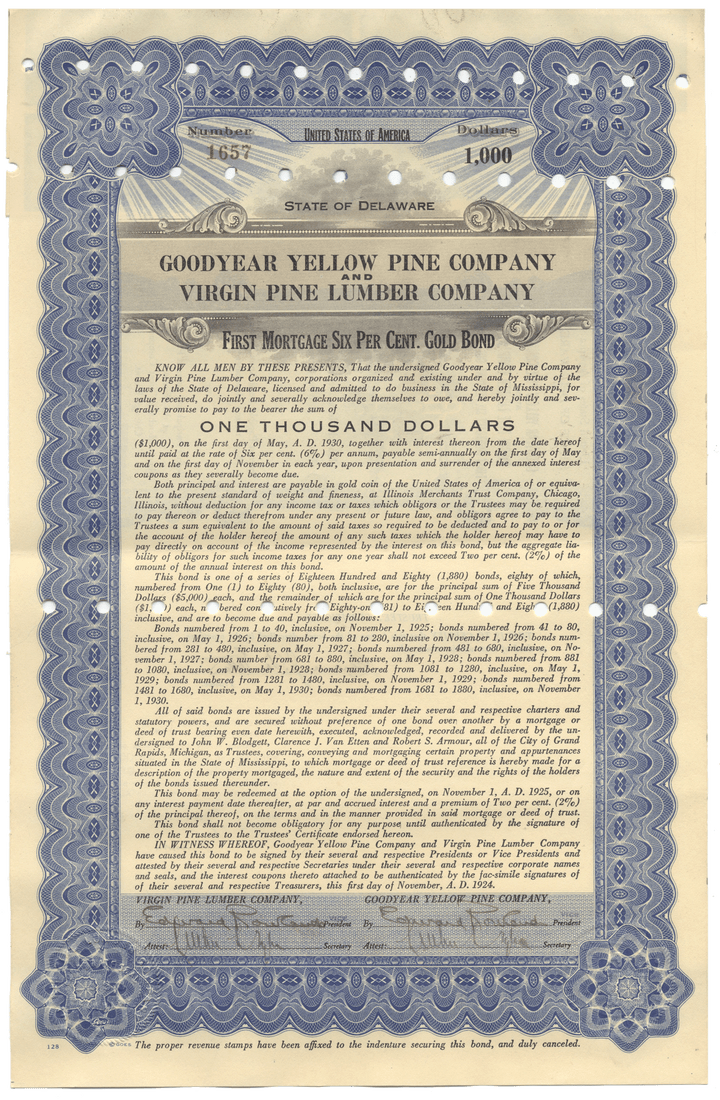Goodyear Yellow Pine Company and Virgin Pine Lumber Company (Signed by Lucius O. Crosby)
- Guaranteed authentic document
- Orders over $75 ship FREE to U. S. addresses
Product Details



Goodyear Yellow Pine Company and Virgin Pine Lumber Company
Certificate Type
First Mortgage Gold Bond
Date Issued
November 1, 1924
Canceled
Yes
Printer
Goes
Signatures
Hand signed
Approximate Size
9 1/2" (w) by 15 1/4" (h)
Additional Details
Signed on verso by Lucius O. Crosby
Historical Context
In March 1917, Miles Goodyear, Lamont Rowlands and Lucius O. Crosby purchased about 42,000 acres of virgin longleaf yellow pine timber from John W. Blodgett, of Grand Rapids, Michigan, the last of the huge Blodgett holdings in Mississippi. This timber was located in the western part of Pearl River County running north and south between Poplarville and Bogalusa. The Goodyear Yellow Pine Company was organized to operate on the newly purchased land with Miles Goodyear assuming the office of president. Miles Goodyear and Lamont Rowlands were the son and son-in-law, respectively, of C. A. Goodyear, who had operated a sawmill in Wisconsin and had large timber interests in the West. In addition, a large wholesale lumber business was conducted in Chicago. The only native Mississippian of the trio was L. O. Crosby, originally from Brookhaven.
Several sites were considered for the erection of two sawmills to manufacture 100,000,000 feet of lumber a year from the newly acquired timber. Among these were Derby and Poplarville, both on the New Orleans & Northeastern, or at a point between Lumberton and Columbia, on the Gulf & Ship Island. Picayune was also considered but not regarded as a probable choice. One sawmill was to be electrically driven and the other steam driven. Plans also called for a paper mill to be built to utilize the waste products from the mills.
In May 1917, the mill location was decided with the purchase by Lamont Rowlands and L. O. Crosby of the sawmill plant, lumber and timber of the Rosa Lumber Company, at Picayune, Mississippi. The property was purchased from R. J. Williams, also of Picayune. Plans were made for the capacity of the Rosa plant to be increased, which at the time of purchase had a cutting capacity of 100,000 feet per day. In addition, a new mill operating under the name Goodyear Yellow Pine Company was to be built one mile east of Picayune with a capacity of 300,000 feet per day. A large paper mill and wood reduction plant were also in the works.
By October 1917, construction of the new three-band sawmill was underway. At the same time the original sawmill of the Rosa Lumber Company, still operating under that name, was running night and day employing about 1,000 men. The Goodyear syndicate had also purchased the Rosa Mercantile Company at a cost of $30,000 in order to operate a commissary in connection with its mill.
The new mill of the Goodyear Yellow Pine Company was placed in operation in February 1919. Its daily capacity was as projected, 300,000 feet per day, which coupled with the 150,000 foot daily capacity of the Rosa mill gave a total of 450,000 feet per day. About 400 men were to be employed at the new Goodyear mill. In January 1926, the Rosa Lumber Company was merged into the Goodyear Yellow Pine Company. The total output of these two mills was sold to the International Harvester Company.
The joint Goodyear Yellow Pine- Rosa Lumber Co. logging railroad was incorporated as the Pearl River Valley Railroad in 1917. Both lumber companies operated private logging spurs off of the Pearl River Valley, which was built northward into the lumber companies' timber holdings.
In July 1932, the two mills were converted to cut hardwoods, in addition to pine. At that time the market was poor for both types of wood. In the spring of 1938, logging by rail was discontinued and the equipment put up for sale. By 1941 the virgin timber was nearly cut out and the Goodyear company was on the verge of liquidation. Liquidation was delayed and with the coming of World War II the company thrived on defense orders and diversified. In February 1950, the name was changed to Crosby Forest Products Company, a name more in keeping with the varied operations of the company.
The Virgin Pine Lumber Company was another Crosby concern that was born from the Blodgett holdings. It was a reorganization of the L. N. Dantzler Lumber Company, which had a mill in Piave, Mississippi. Crosby gained control of the mill in 1923.
Historical Context
Lucius Olen "L.O." Crosby, Sr. (1869-1948) left the family cotton farm with a 3rd grade education at age 19 to work hauling logs behind oxen. He went from logging trees to becoming the largest and wealthiest timber industrialist in Mississippi.
Related Collections
Additional Information
Certificates carry no value on any of today's financial indexes and no transfer of ownership is implied. All items offered are collectible in nature only. So, you can frame them, but you can't cash them in!
All of our pieces are original - we do not sell reproductions. If you ever find out that one of our pieces is not authentic, you may return it for a full refund of the purchase price and any associated shipping charges.









